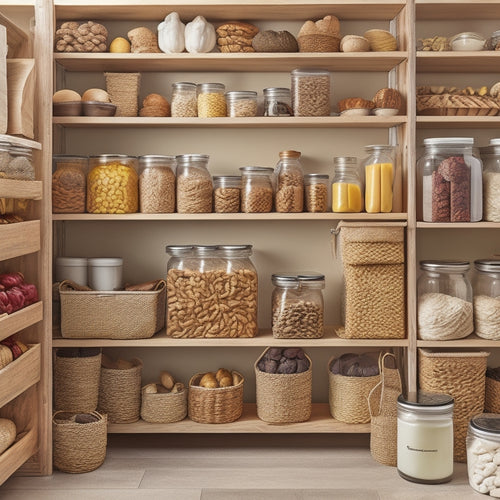
5 Essential Guides to Mastering Meal Planning Chaos
Share
You're tired of feeling overwhelmed by meal planning, but with a few strategic changes, you can transform your kitchen into a haven of efficiency and creativity. Start by streamlining your meal planning process, focusing on healthy, delicious meals that save time and reduce stress. Next, simplify your kitchen storage and prep by assigning designated homes for ingredients and tools. Then, master your grocery shopping list by planning around sales and prioritizing flexibility. Organize your recipes and meal ideas, and establish a routine that works for you. By following these five essential guides, you'll be cooking up a more peaceful, productive kitchen in no time - and discovering a world of culinary possibilities.
Key Takeaways
• Streamline your meal planning process by eliminating unnecessary steps and focusing on healthy, delicious meals to save time and reduce stress.
• Simplify kitchen storage and prep by assigning designated homes for ingredients, tools, and gadgets, and utilizing countertop hacks for maximum efficiency.
• Master your grocery shopping list by planning around sales, stocking up strategically, and prioritizing flexibility to reduce waste and save money.
• Organize recipes and meal ideas by categorizing, creating a system that sparks creativity, and using recipe binders or digital archives for easy access.
• Create a meal planning routine that involves family input, schedules meal prep, and allows for flexibility to ensure a stress-free cooking experience.
Streamlining Your Meal Planning Process
You can simplify your meal planning process by identifying and eliminating unnecessary steps, allowing you to focus on what really matters: healthy, delicious meals for you and your family. By streamlining your process, you'll save time, reduce stress, and enjoy more freedom in the kitchen.
One effective strategy is time blocking, where you dedicate specific times of the day or week to meal planning, grocery shopping, and cooking. This helps you stay on track and avoid last-minute scrambles.
Another game-changer is batch cooking, where you prepare large quantities of a single ingredient or meal component, like rice, beans, or roasted vegetables. This approach saves you time and effort in the long run, as you can reuse these ingredients throughout the week.
Simplifying Kitchen Storage and Prep
Simplifying Kitchen Storage and Prep
Optimize your kitchen's workflow by assigning a designated home for each ingredient, tool, and gadget, making meal prep a breeze. This means creating Kitchen Zones, where similar items are stored together.
For instance, designate a baking zone near your oven, and a cooking zone near your stovetop. Within each zone, organize items by frequency of use, with the most frequently used items front and center.
Next, utilize Countertop Hacks to maximize your workspace. Install a utensil organizer near your cooking zone, and a spice rack near your baking zone. Consider a cart or island with built-in storage to keep ingredients and tools within easy reach.
Mastering Your Grocery Shopping List
With your kitchen workflow optimized, turn your attention to the next hurdle in meal planning: crafting a grocery shopping list that's tailored to your needs and preferences. A well-curated list is key to sticking to your grocery budget and avoiding impulse buys.
To master your list, consider the following:
-
Know your shopper psychology: Be aware of your shopping habits and triggers. Do you tend to overspend on certain items or fall for clever marketing tactics?
-
Plan around sales: Check weekly ads and plan your meals around items on sale to maximize your grocery budget.
-
Stock up strategically: Identify non-perishable staples you use regularly and buy them in bulk to save money and reduce waste.
-
Shop your pantry first: Before heading to the store, take stock of what you already have at home to avoid duplicate purchases.
-
Prioritize flexibility: Leave room for adjustments and substitutions to accommodate changing plans or unexpected sales.
Organizing Recipes and Meal Ideas
As you shift from crafting a tailored grocery list to organizing recipes and meal ideas, categorize your favorite dishes and cooking inspirations into a system that sparks creativity and saves time.
This is where the fun begins! You'll want to create a system that works for you, one that allows you to easily access and reference your go-to recipes. Consider using Recipe Binders, where you can store printed or handwritten recipes, along with notes and variations.
Alternatively, you can create Digital Archives, using note-taking apps or cloud storage to store your recipes and meal ideas. This way, you can access them from any device, anytime.
Organize your recipes by course, ingredient, or cooking method to make meal planning a breeze. You'll be amazed at how this simple step can streamline your cooking process and reduce meal planning chaos.
Creating a Meal Planning Routine
You're now ready to establish a consistent meal planning routine that saves you time and energy by integrating your organized recipes and meal ideas into a practical schedule. This routine will become the backbone of your meal planning strategy, guaranteeing that you're always prepared for the week ahead.
To create a routine that works for you, consider the following:
-
Set a specific morning routine: Allocate a specific time each morning to review your meal plan, make adjustments as needed, and prep for the day's meals.
-
Involve family input: Ask your family members for their input on meal preferences, dietary restrictions, and cooking skills to make sure everyone is on board and excited about the meal plan.
-
Schedule meal prep: Identify specific days and times for meal prep, grocery shopping, and cooking to maintain consistency and efficiency.
-
Plan for flexibility: Leave some room for spontaneity and flexibility in your meal plan to accommodate unexpected changes or events.
-
Review and adjust: Regularly review your meal planning routine and make adjustments as needed to ensure it continues to meet your evolving needs and preferences.
Frequently Asked Questions
How Do I Involve My Family in Meal Planning Decisions?
You involve your family in meal planning decisions by holding regular Family Meetings, where everyone shares their preferences, and practicing Kid Empowerment by letting them help with meal prep and grocery lists, fostering a sense of ownership and teamwork.
Can I Meal Plan for Specific Dietary Restrictions or Allergies?
"You're not stuck in a culinary corner! You can meal plan for specific dietary restrictions or allergies, effortlessly swapping in gluten-free options and allergy-friendly swaps that delight your family's diverse needs, liberating you from mealtime stress!"
What if I Don't Have Time to Cook Every Single Day?
You don't have to cook daily; try batch cooking on weekends and quick prep during the week to save time, ensuring you still eat healthy, stress-free meals that fit your lifestyle.
How Do I Handle Last-Minute Changes to My Meal Plan?
When last-minute changes throw a wrench in your meal plan, you adapt with flexibility strategies like impromptu substitutions, swapping ingredients or meals to keep your sanity and mealtime on track.
Can I Meal Plan for One Person or Is It Only for Families?
You can definitely meal plan for one person! Solo cooking allows you to create a personalized menu tailored to your taste preferences, dietary needs, and busy schedule, giving you total control over your meals.
Related Posts
-

10 Essential Storage Solutions for Bulk Food Storage
You're taking the first step towards maximizing your pantry's potential! Start with airtight containers for dry goods...
-

Revamp Your Space: Decluttering Made Easy
You're about to discover a simple, structured approach to decluttering that breaks down the overwhelming task of reva...

